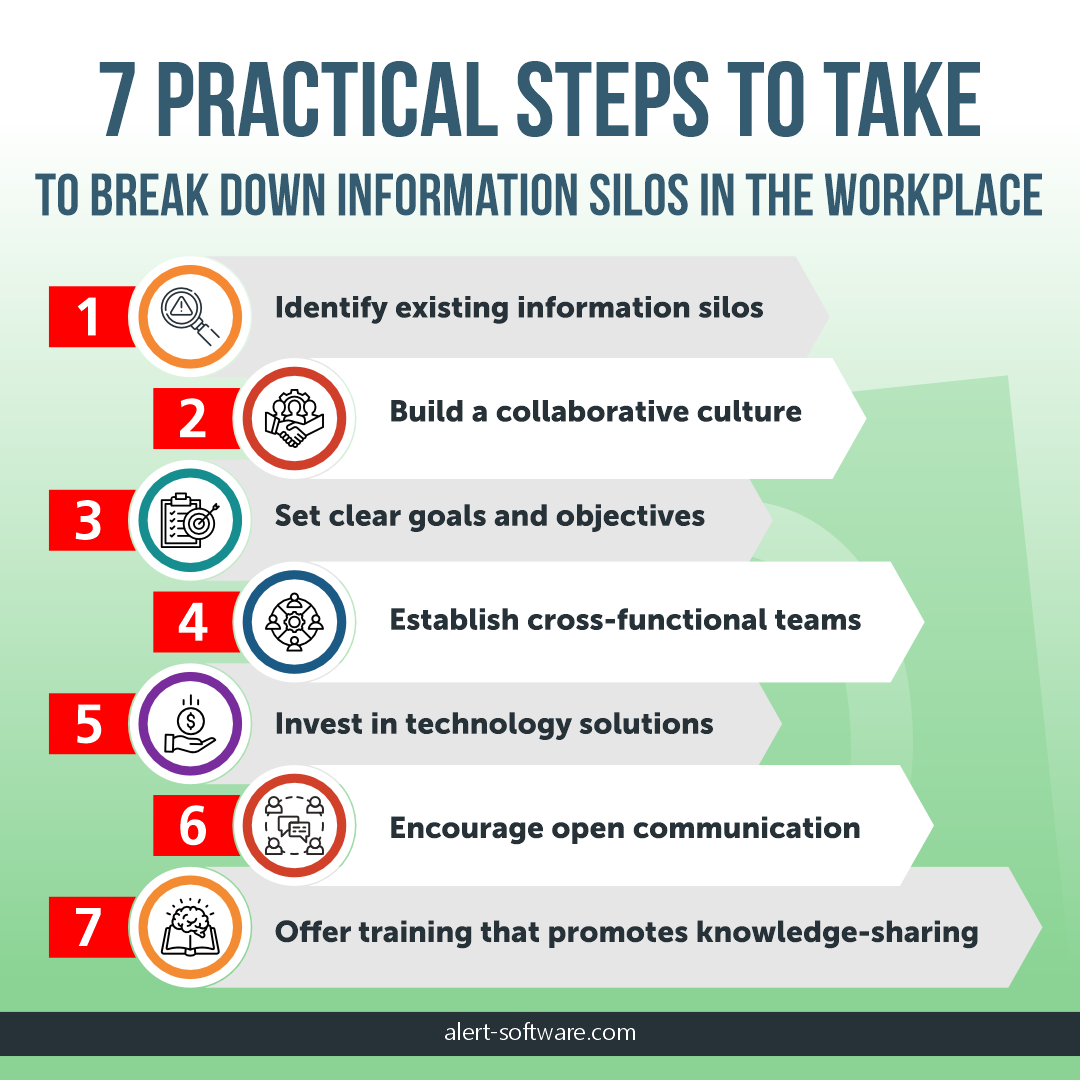
Sharing information effectively in the workplace ensures that management and staff alike are all on the same page, creating a high-performing team environment and working towards achieving corporate goals.
Unfortunately, many organizations fail to share information adequately. A study by market intelligence firm International Data Corporation found that Fortune 500 companies lose around $31.5 billion each year by failing to share knowledge. Understanding the issues that lead to information sharing being blocked and working to strategically reverse or avoid these situations is absolutely necessary to be productive and competitive.
Table of contents
What is the meaning of “organizational silos"?
What are the problems caused by information silos in the workplace?
7 practical steps to take to break down information silos in the workplace
Creative ways to share information across an organization
What is the meaning of “organizational silos"?
Organizational information silos (sometimes also called data silos or knowledge silos) refer to the barriers and isolated pockets of data that exist within a company's structure, hindering efficient communication, collaboration and information sharing.
Building silos is sadly easier than being able to remove them. These silos often emerge when departments or teams within an organization hoard information or fail to integrate it with the broader network. This leads to limited visibility, duplication of efforts, and a lack of holistic understanding across the organization.
Information silos can impede decision-making processes, hamper innovation and hinder overall productivity.
Overcoming siloed teams requires a concerted effort to foster a culture of transparency, establish effective communication channels, and implement integrated technology solutions to ensure seamless information flow throughout the organization.
What are the problems caused by information silos in the workplace?
Information silos have many different negative impacts on an organization and its performance. These include:
- Hindered communication - information silos create communication barriers, limiting the flow of vital information across departments and teams.
- Duplication of efforts - without shared access to information, different teams may unknowingly duplicate work, which is a waste of time, effort, and resources.
- Reduced collaboration - silos discourage collaboration between departments, leading to missed opportunities for cross-functional insights and innovative solutions.
- Inefficient decision making -when crucial information is isolated, decision-making processes become slow and ineffective, hindering the organization's ability to respond quickly to challenges or seize opportunities.
- Lack of accountability - silos can obscure accountability, as responsibility for outcomes becomes difficult to trace.
- Customer dissatisfaction - inconsistent or incomplete information due to silos can result in poor customer experiences, leading to dissatisfaction, reputational damage and potential loss of business.
- Reduced efficiency - silos inhibit efficient workflows, as employees spend additional time searching for information or navigating complex bureaucratic structures.
- Organization lacks adaptability - silos impede organizational agility, making it challenging to adapt to changing market conditions or embrace new technologies.
- Limited knowledge sharing - silos restrict the sharing of expertise and best practices, preventing organizational learning and improvement.
- Missed strategic opportunities - silos hinder an organization's ability to identify and capitalize its strategic opportunities leading to potential competitive disadvantages and decreased growth.
7 practical steps to take to break down information silos in the workplace

1. Identify existing information silos
The first logical step in breaking down information silos is to understand exactly where they are in the organization and what effects they are having. To start, assess the current state of information flow within your organization. Identify the barriers, team silos, departments, or individuals that tend to hoard information.
2. Build a collaborative culture
You can look at the situation as basically working in silos vs collaboration. By encouraging open communication and collaboration across teams and departments, you can promote the idea that sharing information and knowledge is beneficial to the entire organization.
3. Set clear goals and objectives
Clearly define the goals and objectives of your organization and communicate them widely. This includes ensuring that these goals are shared across different teams and departments. This helps align everyone towards a common purpose and facilitates the exchange of relevant information.
4. Establish cross-functional teams
Cross-functional teams is one of the best ways of building bridges for business purposes - it brings together employees from different departments in the organization to work on specific projects or initiatives. Establishing these teams helps to facilitate knowledge sharing, the cross-pollination of ideas and acts as a silo bridge that fosters collaboration.
5. Invest in technology solutions
It’s important to invest in technology tools and platforms that facilitate information sharing and collaboration. This can include implementing project management software, internal communication tools, and knowledge sharing platforms that enable employees to easily access and share information.
6. Encourage open communication
Open communication channels such as regular team meetings, virtual collaboration spaces, and forums help to democratize participation in the workplace and can encourage employees to share updates, insights, and challenges openly. Not only can it help to disseminate information more effectively, it aids with building a cohesive team.
7. Offer training that promotes knowledge-sharing
Develop a knowledge-sharing culture where employees are motivated to contribute and learn from one another. You can do this by encouraging individuals to share their expertise and experiences with others. You can also offer tailored training solutions that capitalize on existing employee knowledge.
>>Learn About DeskAlerts’ Employee Training Software<<
Creative ways to share information across an organization
Breaking down silos in an organization requires a cultural shift and a commitment to fostering a collaborative environment. Here are some creative ways to achieve this:
- Implement internal social networks - these platforms can enable employees from across the organization to connect, share ideas and discuss projects, building a sense of community and bridging silos in the process.
- Offer “lunch and learn” sessions - these are informal events where employees gather on their lunch breaks to share knowledge, insights and expertise.
- Provide opportunities for people to work in different parts of the organization - initiatives such as job shadowing or job rotation can give your staff the opportunity to work in different departments and understand the work they do.
- Use innovative communication channels - it’s time to think outside the box and communicate in ways other than email and intranet. Use digital channels such as pop-up alerts, screensavers, scrolling desktop tickers and digital signage displays to share information across the organization.
- Don’t forget remote or non-desk workers - people who aren’t physically located in the office can be overlooked, and this creates a team silo situation in and of itself. Try an employee app to keep people connected and informed, no matter where they are.
>>Benefits Of DeskAlerts Mobile Alert App<<
- Run mentorship programs - find opportunities to pair employees with mentors from different departments in the organization to promote a broader understanding of the organization.
- Produce internal podcasts or webinars - these are good ways for employees to share their expertise, discuss industry trends or present case studies. These formats allow for easy dissemination of information.
- Organize innovation challenges - these can be run like competitions where teams from different departments work together to solve complex problems, sharing their knowledge and leveraging their diverse perspectives.
***
Commiting to sharing knowledge, updates and best practices and bridging gaps between departments will help you to create a unified workforce.
FAQ:
How do you break down an organizational silo?
Breaking down organizational silos requires a deliberate effort to promote collaboration, communication, and shared goals. This can be achieved by:
- Encouraging cross-functional teams
- Implementing transparent communication channels
- Establishing regular knowledge sharing sessions
- Fostering a culture of open feedback.
How can a process focus help to break down silos in an organization?
A process focus can help break silos in an organization by emphasizing the flow of work across departments, reducing duplication of efforts and aligning efforts towards achieving organizational goals. By mapping and optimizing processes, organizations can identify bottlenecks, streamline handoffs and encourage collaboration.
How do you build a bridge in an organization?
Building a bridge in an organization requires open communication, active listening and fostering relationships. Create opportunities for employees to interact and understand diverse perspective and work towards shared objectives. This helps to bridge gaps and break down barriers.
Which type of perspective is focused on breaking down organizational silos?
A systems perspective is focused on breaking down information silos. It views the organization as an interconnected system where each department’s actions affect the others. It emphasizes the need for cross-functional collaboration, shared goals and open communication.
How to break down silos and make collaboration happen?
Breaking down silos and fostering collaboration requires several key steps:
- Establish a culture of open communication, trust and shared goals.
- Encourage cross-functional teams.
- Provide platforms for knowledge sharing.
- Implement transparent processes.
- Provide opportunities for employees to collaborate on projects.
- Foster a supportive environment where diverse perspectives are valued.
- Recognize and reward collaborative efforts.
 Caroline Duncan
Caroline Duncan







